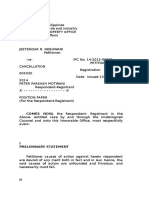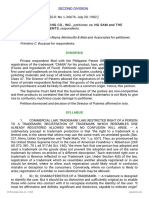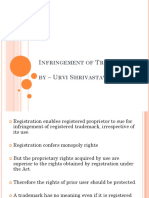Emerald v. Ca - Case Digest
Emerald v. Ca - Case Digest
Uploaded by
des_4562Copyright:
Available Formats
Emerald v. Ca - Case Digest
Emerald v. Ca - Case Digest
Uploaded by
des_4562Original Description:
Original Title
Copyright
Available Formats
Share this document
Did you find this document useful?
Is this content inappropriate?
Copyright:
Available Formats
Emerald v. Ca - Case Digest
Emerald v. Ca - Case Digest
Uploaded by
des_4562Copyright:
Available Formats
Emerald Garment Manufacturing Corp. v. CA G.R. No. 100098 December 29, 1995 Facts: On September 18, 1981 H.D.
Lee Co., Inc., a foreign corporation organized under the laws of U.S.A., filed with the Bureau of Patents, Trademarks & Technology Transfer (BPTTT) a Petition for Cancellation of Registration No. SR 5054 for the trademark "STYLISTIC MR. LEE" used on skirts, jeans, blouses, socks, briefs, jackets, jogging suits, dresses, shorts, shirts and lingerie issued on October 27, 1980 in the name of petitioner Emerald Garment Manufacturing Corporation, a domestic corporation organized and existing under Philippine laws. Private respondent, invoking Sec. 37 of R.A. No. 166 (Trademark Law) and Article VIII of the Paris Convention for the Protection of Industrial Property, argued that petitioner's trademark "so closely resembled its own trademark, 'LEE' as previously registered and used in the Philippines, and not abandoned, as to be likely, when applied to or used in connection with petitioner's goods, to cause confusion, mistake and deception on the part of the purchasing public as to the origin of the goods. On 19 July 1988, the Director of Patents rendered a decision granting private respondent's petition for cancellation and opposition to registration. On appeal, the Court of Appeals affirmed the decision of the Bureau of Patents. Issue: Whether or not the subject trademarks are confusingly similar? Held: More crucial is the issue of confusing similarity between the two trademarks. Petitioner vehemently contends that its trademark "STYLISTIC MR. LEE" is entirely different from and not confusingly similar to private respondent's "LEE" trademark. The pertinent provision of R.A. No. 166 (Trademark Law) states thus: Sec. 22. Infringement, what constitutes. Any person who shall use, without the consent of the registrant, any reproduction, counterfeit, copy or colorable imitation of any registered mark or trade-name in connection with the sale, offering for sale, or advertising of any goods, business or services on or in connection with which such use is likely to cause confusion or mistake or to deceive purchasers or others as to the source or origin of such goods or services, or identity of such business; or reproduce, counterfeit, copy or colorably imitable any such mark or tradename and apply such reproduction, counterfeit, copy, or colorable imitation to labels, signs, prints, packages, wrappers, receptacles or advertisements intended to be used upon or in connection with such goods, business or services; shall be liable to a civil action by the registrant for any or all of the remedies herein provided. Proceeding to the task at hand, the essential element of infringement is colorable imitation. This term has been defined as "such a close or ingenious imitation as to be calculated to deceive ordinary purchasers, or such resemblance of the infringing mark to
the original as to deceive an ordinary purchaser giving such attention as a purchaser usually gives, and to cause him to purchase the one supposing it to be the other." Colorable imitation does not mean such similitude as amounts to identity. Nor does it require that all the details be literally copied. Colorable imitation refers to such similarity in form, content, words, sound, meaning, special arrangement, or general appearance of the trademark or tradename with that of the other mark or tradename in their over-all presentation or in their essential, substantive and distinctive parts as would likely mislead or confuse persons in the ordinary course of purchasing the genuine article. 27 For lack of adequate proof of actual use of its trademark in the Philippines prior to petitioner's use of its own mark and for failure to establish confusing similarity between said trademarks, private respondent's action for infringement must necessarily fail. The questioned decision and resolution are reversed and set aside.
You might also like
- Position Paper Dti CaseDocument11 pagesPosition Paper Dti Casemacebailey100% (3)
- List of The PRIVATE COMPANIES - SPONSORSHIPDocument35 pagesList of The PRIVATE COMPANIES - SPONSORSHIPn krishna chaitanya67% (3)
- Case Digest - PatentDocument11 pagesCase Digest - PatentPem AndoyNo ratings yet
- Emerald Green VS Manufactuing Corp.Document2 pagesEmerald Green VS Manufactuing Corp.Fer Grace AniñonAcabalcuid CatayloNo ratings yet
- Emerald Garment Manufacturing Corporation vs. Hon. Court of Appeals, Bureau of Patents, Trademarks and Technology Transfer and H.D. Lee Company, Inc. G.R. No. 100098, December 29, 1995Document4 pagesEmerald Garment Manufacturing Corporation vs. Hon. Court of Appeals, Bureau of Patents, Trademarks and Technology Transfer and H.D. Lee Company, Inc. G.R. No. 100098, December 29, 1995Marie100% (1)
- Emerald Garment Manufacturing Corporation Vs CADocument3 pagesEmerald Garment Manufacturing Corporation Vs CAJien LouNo ratings yet
- Emerald Garment Manufacturing V CADocument2 pagesEmerald Garment Manufacturing V CAAliw del RosarioNo ratings yet
- Emerald Garment Manufacturing Corp v. Court of AppealsDocument4 pagesEmerald Garment Manufacturing Corp v. Court of Appealsgailacd100% (1)
- IPL Case 1Document32 pagesIPL Case 1Aileen S. BaliloNo ratings yet
- EMERALD GARMENT MANUFACTURING v. CADocument19 pagesEMERALD GARMENT MANUFACTURING v. CAKyla ReyesNo ratings yet
- Supreme Court: Emerald Garments v. CA G.R. No. 100098Document12 pagesSupreme Court: Emerald Garments v. CA G.R. No. 100098Jopan SJNo ratings yet
- Emerald Garment vs. CADocument5 pagesEmerald Garment vs. CAMaribel EusebioNo ratings yet
- Trademark AssignmentDocument4 pagesTrademark AssignmentEdmund LazaroNo ratings yet
- G.R. No. 100098Document9 pagesG.R. No. 100098Louisa QueNo ratings yet
- 127150-1995-Emerald Garment Manufacturing Corp. v. Court20160212-374-1nqvgp PDFDocument17 pages127150-1995-Emerald Garment Manufacturing Corp. v. Court20160212-374-1nqvgp PDFZrm PatNo ratings yet
- Del Monte v. CADocument10 pagesDel Monte v. CARaymond OndesimoNo ratings yet
- Cancellation of Trademark Remedy - Infringement: TopicsDocument11 pagesCancellation of Trademark Remedy - Infringement: TopicsAerylle GuraNo ratings yet
- F1 Philip Morris V Fortune TobaccoDocument3 pagesF1 Philip Morris V Fortune Tobaccogem_mataNo ratings yet
- Del Monte Corpo VS CaDocument7 pagesDel Monte Corpo VS Casamaral bentesinkoNo ratings yet
- Del Monte Vs CaDocument12 pagesDel Monte Vs CaRile NyleveNo ratings yet
- Emerald Garment Manufacturing v. CA, 251 SCRA 600Document13 pagesEmerald Garment Manufacturing v. CA, 251 SCRA 600JMae MagatNo ratings yet
- Del Monte V CADocument10 pagesDel Monte V CAYoo Si JinNo ratings yet
- Famous Trademark DoctrinesDocument5 pagesFamous Trademark DoctrinesHeintje NopraNo ratings yet
- Del Monte Corporation and Philippine Packing Corporation v. CADocument12 pagesDel Monte Corporation and Philippine Packing Corporation v. CAJaymie ValisnoNo ratings yet
- Emerald Garment MFG Group V CADocument12 pagesEmerald Garment MFG Group V CAJenny DagunNo ratings yet
- Passing Off and Infringement of TrademarDocument35 pagesPassing Off and Infringement of Trademarselram2006No ratings yet
- Research - Infringement of Unregistered Trade NameDocument2 pagesResearch - Infringement of Unregistered Trade NameBon HartNo ratings yet
- Del Monte V CA 1990 - Acquisition of Ownership of MarksDocument9 pagesDel Monte V CA 1990 - Acquisition of Ownership of MarksJorel Andrew FlautaNo ratings yet
- Case Digest For AnnexDocument3 pagesCase Digest For AnnexMarieNo ratings yet
- Case Digests Liability For LossDocument6 pagesCase Digests Liability For LossRalph HonoricoNo ratings yet
- Intellectual PropertyDocument21 pagesIntellectual PropertyJonald B. DoradoNo ratings yet
- Del Monte and Sunshine Philippine Packing Corporation vs. CA PDFDocument9 pagesDel Monte and Sunshine Philippine Packing Corporation vs. CA PDFKelvin Jhones AligaNo ratings yet
- Petitioners vs. vs. Respondents Bito, Misa & Lozada Reynaldo F. SingsonDocument9 pagesPetitioners vs. vs. Respondents Bito, Misa & Lozada Reynaldo F. SingsonKristine FayeNo ratings yet
- Emerald Garment Manufacturing Corporation v. Court of AppealsDocument15 pagesEmerald Garment Manufacturing Corporation v. Court of AppealsVic RabayaNo ratings yet
- Rights and Remedies of Owner of TrademarkDocument6 pagesRights and Remedies of Owner of TrademarkGerald MesinaNo ratings yet
- EMERALD GARMENT v. CA G.R. No. 100098 December 29, 1995Document3 pagesEMERALD GARMENT v. CA G.R. No. 100098 December 29, 1995meriiNo ratings yet
- ESSO STANDARD EASTERN, INC., v. CADocument8 pagesESSO STANDARD EASTERN, INC., v. CAKyla ReyesNo ratings yet
- Del Monte vs. CaDocument9 pagesDel Monte vs. CadenvergamlosenNo ratings yet
- Prosource International Inc V Horphag Research ManagementDocument2 pagesProsource International Inc V Horphag Research ManagementJaz SumalinogNo ratings yet
- Emerald Garment Vs CA DigestDocument3 pagesEmerald Garment Vs CA DigestJerome Morada67% (3)
- Finals Digest 1 ClassDocument5 pagesFinals Digest 1 ClassAshley CandiceNo ratings yet
- IPR Unit 3rdDocument14 pagesIPR Unit 3rdSabu janNo ratings yet
- Shiela Mae Ancheta - Trademark Infringment CasesDocument4 pagesShiela Mae Ancheta - Trademark Infringment CasesShiela Mae AnchetaNo ratings yet
- Trademark Cases For IPLDocument6 pagesTrademark Cases For IPLcarinokatrinaNo ratings yet
- Media Law and Ethics: Module 10 - TRADEMARK NotesDocument11 pagesMedia Law and Ethics: Module 10 - TRADEMARK NoteshlouknowNo ratings yet
- Emerald Garment VS CaDocument2 pagesEmerald Garment VS CaNorthern SummerNo ratings yet
- Conflict of Laws FULL CASES 1st BatchDocument153 pagesConflict of Laws FULL CASES 1st BatchTedd MabitazanNo ratings yet
- Trademark DigestsDocument5 pagesTrademark DigestsAdmin DivisionNo ratings yet
- CASE DIGEST: Emerald Garment vs. CADocument3 pagesCASE DIGEST: Emerald Garment vs. CAMie Tot100% (1)
- Del Monte Corp. v. Ca, G.R. No. L-78325, January 25, 1990 1Document5 pagesDel Monte Corp. v. Ca, G.R. No. L-78325, January 25, 1990 1VINCENTREY BERNARDONo ratings yet
- IPL-Esso Standard Vs CADocument3 pagesIPL-Esso Standard Vs CASuiNo ratings yet
- UFC Philippines V Barrio FiestaDocument4 pagesUFC Philippines V Barrio FiestaMaria Therese100% (5)
- 5 - Philippine Refining Co. v. NG SamDocument6 pages5 - Philippine Refining Co. v. NG SamFlorence RoseteNo ratings yet
- Quiz 13Document6 pagesQuiz 13PeperoniiNo ratings yet
- 6 Phil RefiningDocument6 pages6 Phil RefiningMary Louise R. ConcepcionNo ratings yet
- Inringement of TrademarkDocument58 pagesInringement of TrademarkArsh KaulNo ratings yet
- Intellectual Property Law DigestDocument6 pagesIntellectual Property Law DigestMartin PagtanacNo ratings yet
- Dy vs. Koninklijke Philips ElectronicsDocument16 pagesDy vs. Koninklijke Philips ElectronicsJerome ArañezNo ratings yet
- Intellectual Property in Consumer Electronics, Software and Technology StartupsFrom EverandIntellectual Property in Consumer Electronics, Software and Technology StartupsNo ratings yet
- The Pocket Legal Companion to Trademark: A User-Friendly Handbook on Avoiding Lawsuits and Protecting Your TrademarksFrom EverandThe Pocket Legal Companion to Trademark: A User-Friendly Handbook on Avoiding Lawsuits and Protecting Your TrademarksNo ratings yet
- The Pocket Legal Companion to Patents: A Friendly Guide to Protecting and Profiting from PatentsFrom EverandThe Pocket Legal Companion to Patents: A Friendly Guide to Protecting and Profiting from PatentsNo ratings yet
- Anchor Savings v. FurigayDocument16 pagesAnchor Savings v. Furigaydes_4562No ratings yet
- Gutierrez Hermanos v. Orense - 28 Phil 571Document2 pagesGutierrez Hermanos v. Orense - 28 Phil 571alilramonesNo ratings yet
- CREBA v. Executive SecretaryDocument35 pagesCREBA v. Executive Secretarydes_4562No ratings yet
- Ansay v. NDCDocument2 pagesAnsay v. NDCdes_4562No ratings yet
- Republic Act No. 10592Document3 pagesRepublic Act No. 10592Jose_Giovanni__5542No ratings yet
- Shangri-La v. CA Case DigestDocument2 pagesShangri-La v. CA Case Digestdes_4562100% (1)
- Maglasang V NorthwesternDocument1 pageMaglasang V Northwesterndes_4562No ratings yet
- Cagas V COMELEC - Remedial LawDocument2 pagesCagas V COMELEC - Remedial Lawdes_4562No ratings yet
- Pid 2 BombaDocument1 pagePid 2 BombaIvan JulonNo ratings yet
- 2001 Txtpro PartlistDocument82 pages2001 Txtpro PartlistmiguelNo ratings yet
- MRCB BerhadDocument24 pagesMRCB BerhadPiqsamNo ratings yet
- 2019 Motonation Catalog PDFDocument86 pages2019 Motonation Catalog PDFTitanA_ENo ratings yet
- Tutorial 3 SQL Developer Data Modeler and Database LifecycleDocument12 pagesTutorial 3 SQL Developer Data Modeler and Database Lifecycleharikk994No ratings yet
- Scheme of WorkDocument8 pagesScheme of WorkVishnu Sharma0% (1)
- JBoss AMQ 7 Deep DiveDocument35 pagesJBoss AMQ 7 Deep DiveJohn ArcherNo ratings yet
- TSSET Physical Sciences Model PaperDocument16 pagesTSSET Physical Sciences Model PaperMunna MunendharNo ratings yet
- Skill ChartDocument89 pagesSkill ChartVasudev Bhanaji67% (3)
- Model Name: N32N101 Pcbno: La-1011 Date: 2001/09/01 Revision: 1.0Document46 pagesModel Name: N32N101 Pcbno: La-1011 Date: 2001/09/01 Revision: 1.0Xxvic2rxXNo ratings yet
- Johnny Sins Doctor - Google SearchDocument1 pageJohnny Sins Doctor - Google SearchAdelin PopescuNo ratings yet
- BSBDIV501 Unit of Competency Final Result V2Document1 pageBSBDIV501 Unit of Competency Final Result V2Agus BudionoNo ratings yet
- Michael Cover Letter ResumeDocument4 pagesMichael Cover Letter Resumeapi-311952082No ratings yet
- EN-ODY-TM-004 - Nov 2018Document20 pagesEN-ODY-TM-004 - Nov 2018francisco uribeNo ratings yet
- JSP Interview QuestionsDocument15 pagesJSP Interview Questionsgalphatchaitanya24No ratings yet
- 3.1.2 The Allocation of Resources in Competitive MarketsDocument5 pages3.1.2 The Allocation of Resources in Competitive MarketsFattyschippy1No ratings yet
- The Beatles Angielska PrezentacjaDocument12 pagesThe Beatles Angielska Prezentacjakk3071178No ratings yet
- Banshee S03E08 1080p BluRay x264-MRSKDocument60 pagesBanshee S03E08 1080p BluRay x264-MRSKGeorge Alexandru RomanNo ratings yet
- 2019 STEM Applications - FinalDocument81 pages2019 STEM Applications - FinalDavid BumphisNo ratings yet
- Introduction To Strategic Human Resource ManagementDocument9 pagesIntroduction To Strategic Human Resource ManagementjasminemaegermanNo ratings yet
- Iso 12944 P8 2017 enDocument11 pagesIso 12944 P8 2017 enEdgar CerecedoNo ratings yet
- Atest Lva - 440B - 2011Document75 pagesAtest Lva - 440B - 2011Anonymous qpqPIz7OJONo ratings yet
- Airtel Bill For The Period From 05.04.2023 To 04.5.2023 PDFDocument129 pagesAirtel Bill For The Period From 05.04.2023 To 04.5.2023 PDFdlco pvpNo ratings yet
- Ason Gmpls OverviewDocument42 pagesAson Gmpls OverviewhasNo ratings yet
- Applications of Differential Equations in The Financial Industry Chapter 1Document11 pagesApplications of Differential Equations in The Financial Industry Chapter 1Ingrid VillaflorNo ratings yet
- FASHIONDocument14 pagesFASHIONsqxxsnnfdgNo ratings yet
- Y913 33 B22R 0.... 10 BarDocument4 pagesY913 33 B22R 0.... 10 Barap16484No ratings yet
- Me Gate'13Document19 pagesMe Gate'13rajasekharjvNo ratings yet
- Assessment Task 5-Social LiteracyDocument4 pagesAssessment Task 5-Social LiteracySitti Shalyn Arimao100% (1)

































































































